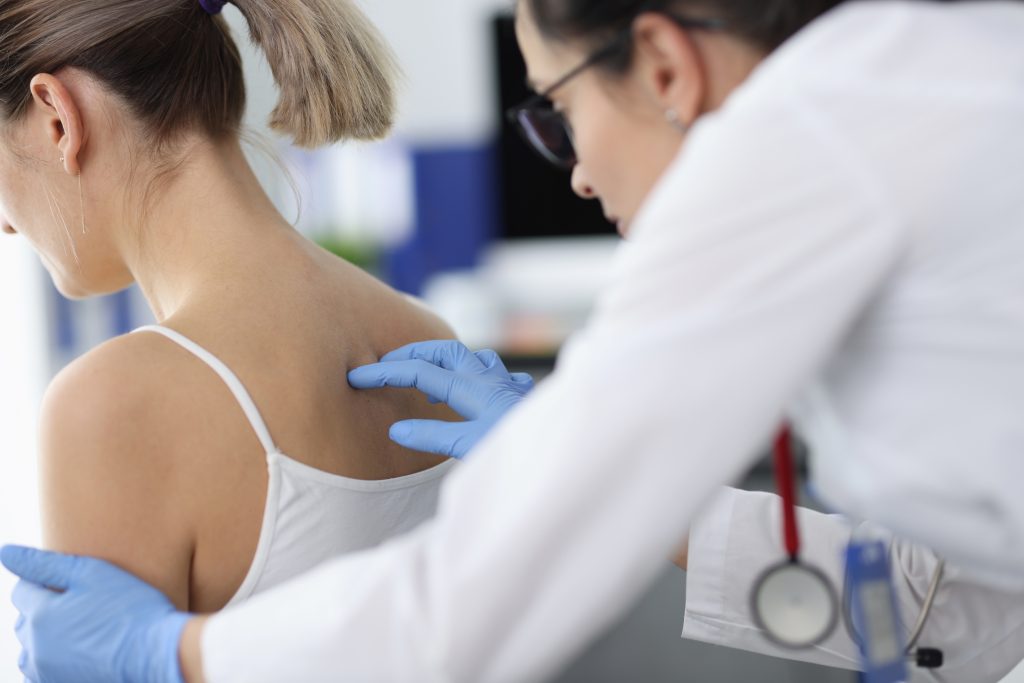
Moles are common in many people, and most are harmless. They typically emerge in childhood and teenage years and can change in size and color as you grow older. Most moles develop when cells, which produce pigment, grow in groups. They can appear as small, round, or oval, and as dark or flesh-colored bumps on your skin. Nearly all moles are around 1/4 inch in diameter and considered benign. As you age, you may start to notice the appearance of new “spots” on your skin – one of which could be a mole, freckle, sunspot, or age spot. Other than being pesky, freckles, sunspots and age spots are generally innocuous. However, if you do notice the presence of a new mole in adulthood, it could potentially mean trouble.
How do you determine next steps and distinguish the difference between an innocent spot and a worrisome mole?
As new moles or growths appear, you should conduct a skin self-exam right away by following the ABCDEs of melanoma, and subsequently schedule an appointment with a dermatologist to make sure your mole isn’t cancerous. Melanoma is the most dangerous and aggressive form of skin cancer. Left untreated, it can spread quickly and become fatal. According to the American Academy of Dermatology, more than 70 percent of melanomas arise from new moles.
To detect melanomas, follow the ABCDE rule and look for growths that are:
- Asymmetrical in size
- Borders are irregular or jagged
- Color is not the same all over, and includes areas of blue, brown, black, or red
- Diameter is larger than the size of a pencil eraser (6 mm)
- Evolving in size, shape, or color
Early identification and diagnosis of precancerous and cancerous lesions increases the likelihood that treatment will be successful. To make a diagnosis, your dermatologist will perform a skin examination, and determine the next steps. Depending on the size, location and severity of the growth, several treatment options are available to remove cancerous cells, including Mohs micrographic surgery, the most effective technique for most types of skin cancers, with minimal scarring or risk.
Other options for treatment include:
Monitoring:
Regular monitoring and supervision by a dermatologist to track any changes in the mole’s appearance over time.
Excisional Biopsy:
Surgical removal of the entire mole for further examination under a microscope to confirm the presence of abnormal cells.
Laser Therapy:
Laser treatment to destroy abnormal cells in the mole, often used for smaller lesions or those in sensitive areas.
Cryotherapy:
Freezing the mole with liquid nitrogen to destroy abnormal cells, typically used for superficial lesions.
Surgical Excision:
Surgical removal of the melanoma and a surrounding margin of healthy tissue to ensure complete removal of cancerous cells.
Chemotherapy and immunotherapy are also treatment options for more aggressive types of skin cancers. As stated above, early detection of skin cancer lesions and moles is crucial because it significantly improves the chances of successful treatment. Skin cancer, including melanoma, is highly treatable when detected early, often with simple and minimally invasive procedures such as the ones mentioned in the list above. However, if left untreated or if detected at an advanced stage, skin cancer can spread to other parts of the body, leading to more serious complications, decreased treatment options, and poorer outcomes.
It’s important to remember that excessive sun exposure can lead to an increased risk of developing skin cancer such as melanoma. To help protect yourself from a diagnosis, you should wear water-resistant and broad-spectrum sunscreen with an SPF of 30 or higher daily, wear protective clothing, avoid tanning beds, and try to seek shade during the hours of 10 a.m. and 4 p.m., since the sun’s UV rays are strongest during that timeframe.
The biggest takeaway?
If you’re an adult, and you notice a new mole, it’s imperative to have it checked by your dermatologist as soon as possible.
Florida Dermatology and Skin Cancer Centers provides a full spectrum of dermatology and skin care services, and its team of physicians, APRNs, and PAs are experts in diagnosing and treating skin cancers, as well as all skin conditions and diseases such as eczema, rosacea, dry skin, rashes, warts and more.
For more information, or to schedule a comprehensive annual skin exam, call (855) FLD-SKIN, or visit www.fldscc.com.


